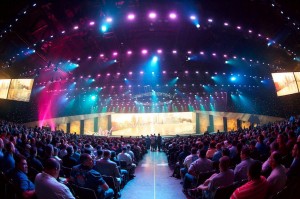As final preparations are underway for the July 31st(9am PT) Let's Chat!#Ciscosmt Training Series USTREAM broadcast, let's get the conversation going early! Are there certain social media examples used for on- and offline events that stick out in your mind? What made them great or perhaps ideas to avoid? And what was used to enhance the participants' experience?
Within my last post on this topic, I mentioned social media is a perfect channel to help on- and offline audiences engage in events and activities. Audiences are able to share their own insights rather than just hearing a speaker present, exchange ideas and connect with others, and add to the overall collaborative experience.

Cisco Live 2013 (Orlando)
Here are some tips to keep in mind when leveraging social media for on- and offline events:
- Audiences:use social media to reach new audience segments for an event. After defining the audience in the overall planning stages and listening to their care-abouts, find ways to involve them in different aspects. E.g., polls to pinpoint most popular topic ideas, word-of-mouth opportunities to spread the word, VIP activities for top influencers, and live tweeting to keep engagement going.
- Duration:leverage social media on an ongoing basis and draw attention to events and activities along the way, as part of the overall ongoing strategy. Depending on the type of event, promotions may begin a few months prior to just 3 weeks. E.g., a large hosted type of event or ongoing online series may require ongoing promotions year-round. Activities such as participating in another organization's event or a webcast type of activity, may only require promotions 3-6 weeks in advance. Event-specific social media efforts should taper off within 1-2 weeks afterwards, folding back into the regular ongoing efforts.
- SEO:include popular tags, Cisco and/or third-party hashtags, and keywords can greatly increase visibility for an event or activity. Take time to research these tags prior to beginning event-related social media efforts, maximizing efforts and reaching the appropriate audiences.
- Monitoring and Measuring:create a program-specific listening and respond plan as part of the overall listening strategy. Since on- and offline events are happening in real-time, planning teams need to monitor constantly and handle responses in a timely manner. And when it comes to measurement, its best to focus on quantitative (number of responses, reach, etc.) and qualitative metrics (sentiment, influencers, etc.). These efforts can help teams benchmark and better understand areas of success and ways they can continue to improve strategies moving forward. (Check out this Cisco Live 2013 Orlando Listening Hub recap blog post, by Cisco's Davythe Dicochea, for additional insights.)
- Integration:tap into existing brand and third party accounts whenever possible rather than creating new ones. It will help continue more meaningful engagements with audience members, tap into existing and established channels, and continue to build reputation and trust among interested parties. Look for the most appropriate accounts and create/use content that relates to the audience's care-abouts within each channel.
- Activities:create a mix of posts, tweets, images, videos, traditional marketing, and activities to provide a full customer journey. As these assets and communications are developed or leveraged, find ways to keep the audience members engaged, focusing on their care-abouts. And just as importantly, make it fun as they get ready to participate in an event, engage with them during the event, and help the audience be the heroes of their organizations afterwards by providing helpful follow-up resources.
- Experimentation:pilot new ideas to better understand how innovations or strategies can be implemented for future tactics and increased audience participation. Don't be afraid to make a mistake. This is part of the process and can often lead to even more innovative approaches.
- Messaging:use social media to create 2-way dialogues for on- and offline events rather than just broadcasting upcoming activities. Communications should include a balance of consistency and variety to keep conversations fresh and relevant. And be sure to customize the messages by social media channel, taking into consideration format and communication best practices. Lastly, make it easy of audience members to share and follow information by incorporating social media channel links in all communication vehicles.
Are there other social media best practices for on- and offline events you've seen work well? Share them with us within this blog post and during our upcoming Let's Chat!#Ciscosmt Training Series USTREAM broadcast. And we look forward to your participation at this upcoming live online session! Here are the details to participate:
- When:Wednesday, July 31st
- Time:9-9:45 a.m. PT
- Topic:Using Social Media for On- and Offline Events
- Hashtag: #Ciscosmt (use this hashtag to ask panelists questions and to participate in the conversation)
- Panel:
- Jeanette Gibson, Senior Director, Digital and Social Media Marketing, Cisco(moderator)
- Kathleen Mudge, Social Media Program Manager, Cisco(panelist)
- Matt Rozen, Group Manager Corporate Social Media, Adobe(panelist)
- Brian Ellefritz, Vice President, Global Social Media, SAP(panelist)
If you have any questions or are interested in other types of social media training, check out our new complimentary Cisco Social Media Training Program and follow the#ciscosmt hashtag. To request customized one-on-one team training sessions, email [email protected].
































 Cisco Live 2013 (Orlando)
Cisco Live 2013 (Orlando) Hot Tags :
Education
Events
learning
ciscosmt
B2B
information-sharing
B2C
#eventprofs
event professionals
Hot Tags :
Education
Events
learning
ciscosmt
B2B
information-sharing
B2C
#eventprofs
event professionals